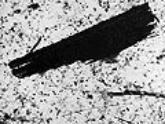WHAT IS AN ASBESTOS FIBER?
From our perspective these are fibers that have the mineralogy and chemical structure that are hazardous to human health when
inhaled or ingested. It is well known that Save Lake Superior Association was born out of popular concern for the quality of the water
in Lake Superior. The long and continuing struggle with the mining companies at Silver Bay, Minnesota to prevent pollution of the
Lake and its watershed has been focused on the discharge of water and air filled with these pollutants. The asbestos fiber has
become the poster child of this conflict.
Asbestos fibers occur in taconite and sulfide ore deposits
Word games and other semantic maneuvers have been used to disguise the nature and danger of mineral fibers being discharge
by taconite and other mineral processing plants from Silver Bay to Grand Rapids on Minnesota’s Iron Range. The mineral fibers
produced by the mining and grinding of taconite and sulfuric hard rock ores include asbestos fibers among other harmful but less
toxic fibers. Today’s technology of air particle monitors, fiber sample analysis equipment and fiber identification science has
removed doubt about the presence of the amphibole class of asbestos fibers in the air and water surrounding the mines and plants.
Characteristics of the fibers that can cause lung, cardiac and gastrointestinal diseases include
• Diameters as small as .02 micrometers with lengths from .06 to greater than 10 micrometers.
• A length to diameter ratio of 3:1 is generally accepted as minimum for counting purposes.
• All fibers in the amphibole class of asbestos have similar structure and chemistry.
• They are easily inhaled and ingested and stick in the lungs and internal organs indefinitely.
• Have chemically reactive surfaces.
• Easily split into many needle-like slivers.
Mechanical grinding of the fibers does not reduce their potency
Fibers in processed ore and waste rock continue to have a mineralogical structure and chemistry that present a health risk to the
public. The size and shape of the fibers may change in response to physical, chemical and biological processes. However, the
cleavage of these fibers during the grinding operation is unlikely to reduce the toxicity of the fiber fragments.
The USEPA, MSHA, OSHA and mining companies all have different definitions of the word, “asbestos” for their own purposes. Your
body doesn’t care what the fibers with these characteristics are called. They present a threat and are generally understood by the
public as capable of causing serious illness.
Where are Asbestos Fibers Found?
Asbestos fibers are found in the air and in surface dirt due to both natural and human disturbances. Naturally occurring asbestos is
found near fault lines such as in El Dorado Hills, CA. Asbestos from human disturbance is found near mineral mines and
processing plants such as those in Libby, Montana, Silver Bay, Minnesota and on Minnesota’s Iron Range. A section of a larger
matrix shows that many of the same amphibole asbestos minerals occur throughout the US.
Natural and Mining Asbestos Matrix
Enough is known About....
Asbestos, Asbestos-like and Similar Synthetic (Nano) Fibers to Warrant their Strict Control.
• Asbestos related diseases can be prevented by eliminating or limiting exposures to these and similar fibers.
• Foreign imports containing asbestos fibers must be controlled the same as domestic products.
• Federal air quality standards must be improved to protect the public from exposure to unsafe levels of asbestos fibers.
|

| Asbestos Fiber |

| Save Lake Superior Association |

| Fibers |